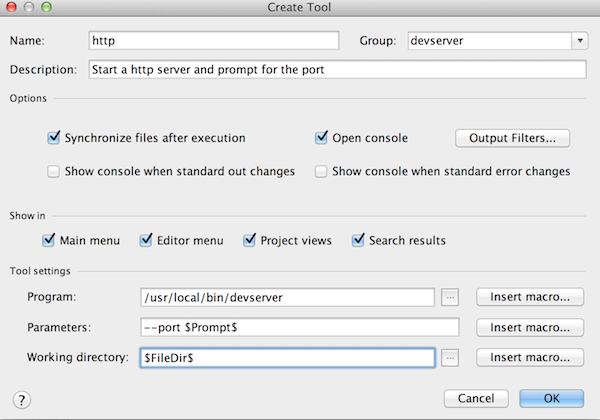grunt-devserver v0.6.0
Developer Web Server
grunt-devserver provides a simple way to quickly get a development server serving up your content with
- run from the command line or Grunt 0.4.x
- no caching content
- CORS headers for cross-domain requests
- logs requests to console
- quickly configure https server
- redefine your middleware in configuration
As a developer I needed a lightweight way to serve up client-side applications and content in isolation from a larger server application. Something that supported a rapid workflow and integrated with my tools.
Installation
Install it from the command line into your project
npm install grunt-devserver --save-devOr install it globally
npm install grunt-devserver -gUsage
From the Command Line
Once grunt-devserver has been installed globally you can run it from any folder by typing devserver
Command line options:
-t, --type (server type) http|https (default is http)
-p, --port (port number) listen on this port
-f, --folder (full path to a folder) serves this folder
-s, --server start a server as defined in the configuration
--cache (method) the method to return in the Cache-Control HTTP header. Default is no-cache.
--file (filename) loads a js/json configuration fileFor more information on configuration files see Configuration Files
From Grunt
To start a server through grunt you need a devserver configuration in your Gruntfile.js and tell
grunt to load grunt-devserver as an available task. For more information see Configuring Tasks.
var config = {devserver: {server: {}}}
grunt.initConfig(config)
grunt.loadNpmTasks('grunt-devserver')and execute using:
grunt devserverNow you can add the following options:
devserver: { options: { 'type' : <string> (http|https defaults to http)
, 'port' : <port number> (defaults to 8888)
, 'base' : <directory> (defaults to .)
, 'cache' : <string> (defaults to 'no-cache')
, 'httpsOptions' : <object> https.createServer options
, 'file' : <filename>
, 'async' : <boolean> (defaults to true)
, 'middleware' : <array> || <function> (defaults to predefined middleware)
}
}NOTE: Starting multiple devservers requires setting the async option to false so that other server tasks may be
processed. async can also be useful when a server is needed to support integration or functional testing.
See the Configuration section for more information.
From Your Project
You can also use devserver directly as a module in your project.
var devserver = require('grunt-devserver')
, options = { type: "http", port: 8000 }
, serverStarted = devserver(options)
serverStarted.then(function(server) {
// TODO something awesome
})From WebStorm
As a developer tool integration is extremely important. If you are using a Jetbrains IDE like WebStorm here are instructions to start a devserver directly in your IDE by adding an entry to your External Tools:
- Go to Preferences > External Tools
- Click Add
- Fill in the form:
- name: http
- group: devserver
- program: /usr/local/bin/devserver
- paramters: --port $Prompt$
- working directory: $FileDir$
- Hit OK. You should now be able to right-click on any folder and start your devserver!

Troubleshooting
Q: I am getting "env: node: No such file or directory"
You need to add node to your path. On a Mac 10.8.x or later see launchctl man page for more information.
- From a terminal run
sudo vim /etc/launchd.conf - Add
setenv PATH /usr/bin:/bin:/usr/sbin:/sbin:/usr/local/bin - Reboot
Configuration
Configuration files provide you with the same functionality as a grunt configuration and can easily be shared across projects or used from the command-line.
Options
type
The type of server
Type: string
Default: http
Command line: -t, --type
port
The port where the server will respond
type: number
default: 8888
command line: -p, --port
base
The base directory of the web server. This is where files will be served. This configuration is passed to the
serve-index middleware.
type: String
default: '.'
command line: -f, --folder
cache
The type of caching mechanism to use. The noCacheHeaders middleware uses this value to add Cache-Control
headers to the HTTP response.
type: String
default: no-cache
command line: --cache
httpsOptions
httpsOptions are passed directly through to node's https.createServer() method. Read the docs for more information.
This is ignored unless the server type is specified as https. When a signing certificate is not present, one will be
automatically generated.
type: object
default: none
file
As external configuration file. See Using Configuration Files for samples on how to use file configurations with devserver
type: string
default: none
command line: --file
async
async if set to true it will keep Grunt from terminating (see Grunt Tasks)
type: boolean
default: true
middleware
Redefines the middleware stack to be used by the server.
type: array or function
default: @see model/CommonConfig.defaultMiddleware
Example: redefine the middleware to log the request and send a hello world message
{ options: { middleware: [ morgan()
, function(req, res, next) {
res.send('Hello world!').end(200)
}
]
}
}Routes can also be used to define specific middleware handlers
var route = require('devserver').middleware.route
var morgan = require('morgan')
function getName(req, res, next) {
// retrieve the user name
}
function putName(req, res, next) {
// update the user name
}
{ options: { middleware: [ morgan()
, route('/name/:id').get(getName).put(putName)
]
}
}Option Precedence
When a property exists in the grunt/command-line configuration and in the configuration file, the grunt/command-line option always overrides the file options.
Example
A example devserverrc file
{ "options": { "type" : "http"
, "port" : 8888
}
}When this file is loaded from the command-line
devserver --file "./devserverrc" --port 4321 --cache "no-store"The resulting configuration used by devserver
{ "options": { "type" : "http"
, "port" : 4321
, "cache" : "no-store"
}
}
